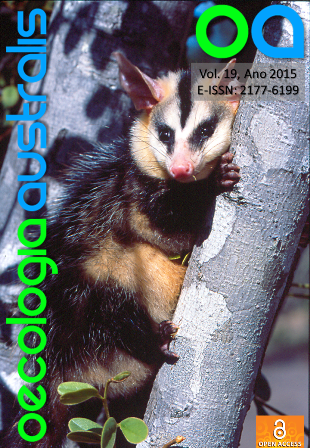UNDERSTANDING THE RELATIONSHIP BETWEEN A. ULULATA AND A. BELZEBUL (PRIMATES: ATELIDAE) BASED ON CYTOGENETICS AND MOLECULAR PHYLOGENY
DOI:
https://doi.org/10.4257/oeco.2015.1901.11Keywords:
Alouatta, karyotype, MT-CYB, phylogenyAbstract
The genus Alouatta Lacépède 1799 comprises a group of neotropical primates distributed from southern Mexico to northern Argentina. Ten species of Alouatta occur in Brazil, including Alouatta belzebul (Linnaeus, 1766) and A. ululata Elliot, 1912; this latter being considered a full species or a junior synonymous of A. belzebul. In order to clarify the relationship of A. ululata with A. belzebul and inferring their relationships with other Alouatta species, karyotyping and mitochondrial DNA data were analyzed. Phylogenetic analyses were carried out with a 801 pb fragment of cytochrome b DNA of one specimen of A. ululata and 33 sequences of A. belzebul, A. caraya, A. fusca, A. nigerrima, A. seniculus, A. macconnelli available in GenBank, with Brachyteles arachnoides as outgroup. The G-band karyotype of a male A. ululata showed a diploid number of 49, similar to the one reported for A. belzebul, with the same pattern of autosome heteromorphism, apparently resulting from a Y-autosome translocation. Maximum-likelihood and Bayesian analysis and median joining network did not show an internal structure within A. belzebul and placed A. ululata haplotype within the A. belzebul clade. Karyotypic and molecular analyses herein carried out corroborate did not allow the separation of A. ululata from A. belzebul.Downloads
Download data is not yet available.
Downloads
Additional Files
- manuscript (Português (Brasil))
- camiladebarros, OA_Viana_et_al_Figure_1.doc (Português (Brasil))
- camiladebarros, Viana_et_al_figure_2.JPG (Português (Brasil))
- camiladebarros, Viana_et_al_figure_3.JPG (Português (Brasil))
- camiladebarros, Viana_et_al_figure_4.JPG (Português (Brasil))
- camiladebarros, Prezada Editora mod Nat.doc (Português (Brasil))
- camiladebarros, OA_Viana_et_al_Figure_1.tif (Português (Brasil))
- camiladebarros, OA_Viana_et_al_figure_2.JPG (Português (Brasil))
- camiladebarros, OA_Viana_et_al_figure_3.tif (Português (Brasil))
- camiladebarros, OA_Viana_et_al_figure_4.tif (Português (Brasil))
- camiladebarros, OA_Viana et al_reviewer B.docx (Português (Brasil))
- camiladebarros, Prezada Editora_2 mod nat.doc (Português (Brasil))
Published
2017-02-23
Issue
Section
Articles


